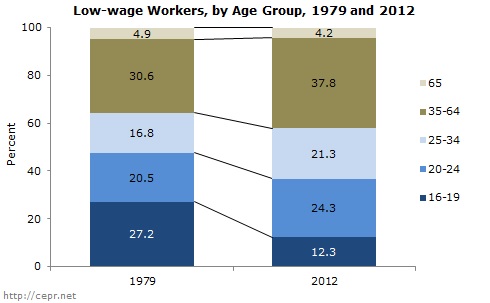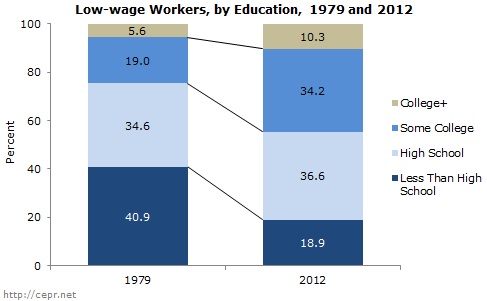Article
Fact-based, data-driven research and analysis to advance democratic debate on vital issues shaping people’s lives.
Center for Economic and Policy Research
1611 Connecticut Ave. NW
Suite 400
Washington, DC 20009
Tel: 202-293-5380
Fax: 202-588-1356
https://cepr.net
As we documented in an earlier post, the current value of the minimum wage is too low by every available historical benchmark. But, given the age and educational upgrading of the average low-wage worker over the last three decades, the level of the minimum wage is positively awful.
Economists generally believe that older, better-educated workers should earn higher wages than younger, less-educated workers. An older worker typically has more experience and on-the-job training, both of which increase skills. Education – whether it is a high school degree, an associate’s degree, a bachelor’s degree, or more – also increases workers’ skills and should be rewarded in the labor market. The falling value of the federal minimum wage, however, has failed to recognize substantial increases in the education and training of the workforce.
Table 1 summarizes the characteristics of low-wage workers by age and education, which we define as those earning less than or equal to $10.10 per hour (in inflation-adjusted 2012 dollars), the level of the minimum wage proposed by the Fair Minimum Wage Act of 2013.

Between 1979 and 2012, the average age of a low-wage worker rose from 32.3 to 34.9 years old. This increase reflected the falling share of low-wage workers who are teenagers (down from 27.2 percent in 1979 to 12.3 percent in 2012) and a rising share of workers between the ages of 25 and 64 (from 47.5 percent of the low-wage workforce in 1979 up to 59.1 percent in 2012, see Figure 1).

Low-wage workers are also much better educated today than they were three decades ago. The share of low-wage workers with less than a high school degree has dropped by more than half, from 40.9 percent in 1979, to 18.9 percent in 2012. Meanwhile, the share with more than a high school degree, but short of a four-year college degree, increased considerably, from 19.0 percent in 1979 to 34.2 percent in 2012. And, by 2012, one-in-ten (10.3 percent) low-wage workers had a college degree or more, compared to only about one-in-twenty (5.6 percent) in 1979 (Figure 2).

While the low-wage workforce is older and much better educated today than three decades ago, it is working for substantially less today than at the end of the 1970s, when the country was much poorer than it is today.